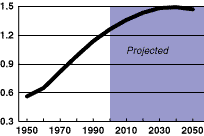
For China, a Census That Really Counts
(December 2000) Tracking down more than one billion Chinese citizens is no easy task, but China’s government is about to try. From November 1 to 15, more than five million census-takers will visit China’s estimated 350 million households to conduct the fifth national census since the founding of the People’s Republic in 1949. The reliability of the data will be a question, to be sure, especially since local officials pay a price if births in their bailiwick exceed targets. Even so, the final tally will be viewed in Beijing as a report card on the government’s population stabilization program, possibly leading to a tightening of birth restrictions even as family planning services continue to expand.
The official goal is to be under 1.3 billion. If the census total (due in February) surpasses that figure, some experts believe the government will step up pressure on families to limit births. “I don’t think they’ll change the rules, but they could get tougher on enforcement,” says Susan Greenhalgh, a China population specialist at the University of California-Irvine. Current rules limit most urban couples to one child — two if both parents are only children — while rural residents may have two children. These limits are widely evaded, however, and implemented unevenly throughout China, making enforcement a key issue. The 1990 Census revealed higher than expected fertility levels and was followed by a draconian toughening of enforcement, though no clear-cut connection between the two has been documented.
If the government meets its goal, stricter enforcement is not expected to be as high a priority. In some cases, modest adjustments to the urban one-child policy might even be possible. Officials in Shanghai have already granted residency rights to second-born children, giving them access to public education and health care. Any future reforms are likely to be downplayed, however, and coupled with calls for achieving national population targets. “There’s a tremendous fear that if they liberalize too quickly, people will rush to have more children,” says Greenhalgh, “so there’s a go-slow approach to reform.”
China’s Population, 1950-2050

Source: U.S. Census Bureau, International Data Base.
Whether or not the census results please Beijing, the government will probably continue its efforts to improve the availability and quality of family planning services, a movement underway since the mid-1990s. Family planning service centers have sprung up across China, offering method choice counseling, reproductive health services, prenatal care, and pre-marital counseling. The government estimates that 660 of China’s 3,000 counties have participated in the movement so far, marking a sizable shift in how population goals are pursued in some areas. “There has been a sea change in attitude, rhetoric, and intention,” says Joan Kaufman of the Ford Foundation in Beijing, though she is quick to point out that local approaches vary widely and that much retraining is needed.
China’s interest in the quality of family planning services, with increased emphasis on reproductive health, was sparked by the 1994 International Conference on Population and Development in Cairo, which stressed the value of such services. The State Family Planning Commission (SFPC) first introduced the reforms in 1995, starting with six rural counties and five urban districts in eastern China. The UN Population Fund and the Ford Foundation became involved in funding the reform effort through the SFPC in the late 1990s.
The government’s interest in family planning as a means of moderating population growth has also risen as China’s economy has shifted from state planning to free-wheeling markets, a transition that has made coercive approaches less workable. The erosion of control has been particularly pronounced in the countryside, where the majority of China’s population still resides. Increasingly affluent parents can often afford to pay the fines or bribes necessary to have above-quota children, or simply travel to a new area to escape scrutiny. As a result, while the government claims that the national fertility rate is 1.8 children per woman, some Chinese demographers believe the real number lies between 2.0 and 2.3. With traditional controls looking ineffective, the government appears to hope that a more customer-oriented approach will fit better into China’s changing society.
Although Chinese officials are reportedly happy with the results of the reforms undertaken so far, practical obstacles will impede the expansion of family planning services in the future. Among other problems, shortages of technical expertise and limited funding are key constraints. Financial concerns are compounded by wasteful duplication of services between the family planning service centers and local health facilities, a problem that has sparked heated debate in Beijing.
And as for birth restrictions, while officials may tinker with the policy, there is broad consensus in China that controlling population growth remains critical to the country’s development. In March, for example, the government announced plans to apply birth limits more strictly to China’s ethnic minorities, groups that have been relatively free from such controls in the past. “It would be a fantasy to think that the population stabilization goals will go away — they won’t,” says Kaufman. “It’s how they’re pursued that is the question.”
Bingham Kennedy, Jr. is associate editor of Population Today.
